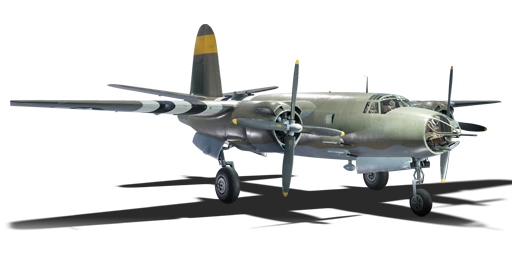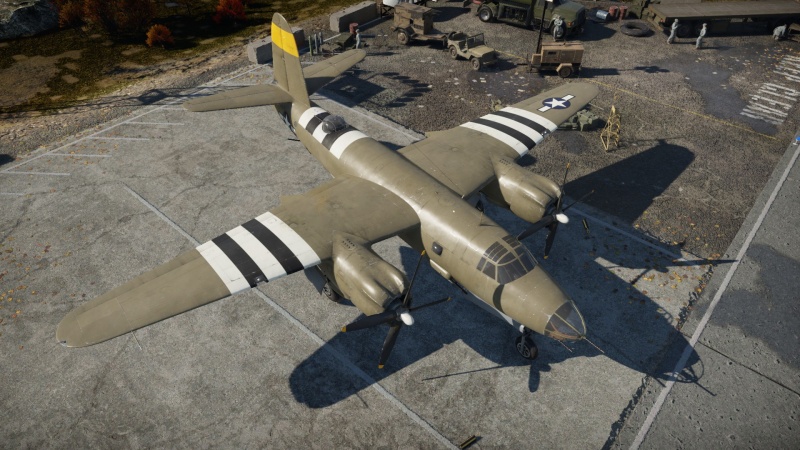B-26B
| This page is about the American bomber B-26B. For the French version, see B-26C. |
Contents
Description
The B-26B Marauder is a rank III American bomber with a battle rating of 4.3 (AB/RB) and 4.7 (SB). It was introduced in Update "Wind of Change".
General info
Flight performance
| Characteristics | Max Speed (km/h at 3,962 m) |
Max altitude (metres) |
Turn time (seconds) |
Rate of climb (metres/second) |
Take-off run (metres) | |||
|---|---|---|---|---|---|---|---|---|
| AB | RB | AB | RB | AB | RB | |||
| Stock | 403 | 387 | 8500 | 35.3 | 36.6 | 2.4 | 2.4 | 950 |
| Upgraded | 525 | 491 | 32.8 | 34.0 | 10.3 | 5.6 | ||
Details
| Features | ||||
|---|---|---|---|---|
| Combat flaps | Take-off flaps | Landing flaps | Air brakes | Arrestor gear |
| ✓ | ✓ | ✓ | X | X |
| Limits | ||||||
|---|---|---|---|---|---|---|
| Wings (km/h) | Gear (km/h) | Flaps (km/h) | Max Static G | |||
| Combat | Take-off | Landing | + | - | ||
| 568 | 265 | 382 | 320 | 297 | ~__ | ~__ |
| Optimal velocities (km/h) | |||
|---|---|---|---|
| Ailerons | Rudder | Elevators | Radiator |
| < 270 | < 320 | < 370 | > ___ |
Survivability and armour
Examine the survivability of the aircraft. Note how vulnerable the structure is and how secure the pilot is, whether the fuel tanks are armoured, etc. Describe the armour, if there is any, and also mention the vulnerability of other critical aircraft systems.
Modifications and economy
Armaments
Offensive armament
The B-26B is armed with:
- 1 x 12.7 mm M2 Browning machine gun, nose-mounted (200 rpg)
- 4 x 12.7 mm M2 Browning machine guns, cheek-mounted (250 rpg upper + 200 rpg lower = 900 total)
Suspended armament
The B-26B can be outfitted with the following ordnance:
- 30 x 100 lb AN-M30A1 bombs (3,000 lb total)
- 14 x 300 lb H.E. M31 bombs (4,200 lb total)
- 8 x 600 lb H.E. M32 bombs (4,800 lb total)
- 4 x 1,000 lb AN-M65A1 bombs (4,000 lb total)
- 2 x 2,000 lb AN-M66A2 bombs (4,000 lb total)
- 1 x 1,927 lb Mk.13-1 torpedo
Defensive armament
The B-26B is defended by:
- 1 x 12.7 mm M2 Browning machine gun, nose turret (270 rpg)
- 2 x 12.7 mm M2 Browning machine guns, dorsal turret (400 rpg = 800 total)
- 1 x 12.7 mm M2 Browning machine gun, 2 x beam turrets (240 rpg)
- 2 x 12.7 mm M2 Browning machine guns, tail turret (800 rpg = 1,600 total)
Usage in battles
Describe the tactics of playing in the aircraft, the features of using aircraft in a team and advice on tactics. Refrain from creating a "guide" - do not impose a single point of view, but instead, give the reader food for thought. Examine the most dangerous enemies and give recommendations on fighting them. If necessary, note the specifics of the game in different modes (AB, RB, SB).
Manual Engine Control
| MEC elements | ||||||
|---|---|---|---|---|---|---|
| Mixer | Pitch | Radiator | Supercharger | Turbocharger | ||
| Oil | Water | Type | ||||
| Controllable | Controllable Not auto controlled |
Not controllable Not auto controlled |
Controllable Auto control available |
Separate | Controllable 2 gears |
Not controllable |
Pros and cons
Summarise and briefly evaluate the vehicle in terms of its characteristics and combat effectiveness. Mark its pros and cons in the bulleted list. Try not to use more than 6 points for each of the characteristics. Avoid using categorical definitions such as "bad", "good" and the like - use substitutions with softer forms such as "inadequate" and "effective".
Pros:
Cons:
History
The Martin B-26 medium bomber was submitted by the Glenn L. Martin company in 1939 to the same USAAC specification (Circular Proposal 39-640) as the North American B-25 Mitchell, and both were accepted off the drawing board. Unsurprisingly, the two airplanes share much in common: twin-engined medium bombers, similar in size, with similar offensive and defensive armament. Both saw service in all major theaters of the war, with both U.S. and allied forces.
What sets the B-26 Marauder apart is that it was designed for speed; designed around two massively powerful Pratt & Whitney R-2800 radial engines, its maximum speed is a full 10% faster than its slightly smaller and lighter B-25 counterpart. However, this speed came at a cost. With high wing loading and demanding flight characteristics, the B-26 was noticeably harder to fly than the Mitchell. This pilot skill differential, combined with the pressures of wartime training, led to a track record of deadly crashes early in the plane’s history, gaining a reputation as a “widow maker”.
Despite this unpromising start to its career, the B-26 Marauder racked up a solid combat record. Mostly deployed at medium altitude missions, it became known for accurate bombing, and by the end of the war, the U.S. 9th Air Force reported that the so-called “widow maker” recorded the lowest combat loss rate of any aircraft type.[1] One B-26, named “Flak Bait”, survived over 200 missions and is on display at the Smithsonian Institution's Steven F. Udvar-Hazy Center.[2]
Although most of its combat flying was done in the European Theater of Operations, a notable early engagement in the Pacific was the sortie of four torpedo-equipped Marauders against the Japanese fleet during the Battle of Midway. None of the torpedoes hit, two of the planes were lost, and the other two returned so badly shot-up that they were written off. Over the fleet and pursued by Japanese A6M Zeroes, a B-26 named “Susie Q” actually overflew the length of the Akagi’s flight deck at very low level, strafing the deck crew with its machine guns. Susie Q landed, just barely, back at Midway with over 500 bullet holes.[3]
The in-game version represents the B-26B model after some modifications had been made, including lengthening the wings to improve (but not eliminate) the tricky handling characteristics. Most B-26 were built at the Glenn L. Martin plant in Baltimore, Maryland, but the essentially identical B-26C (found in the French tech tree) was built in Omaha, Nebraska. A total of 5,288 aircraft of all models were built between 1941 and 1945.[4]
Confusingly, in later years (after the Marauder was retired from service), the USAF from 1947 to 1966 reclassified the Douglas A-26 as "B-26", before eventually reverting to the A-26 nomenclature.[5]
Media
Excellent additions to the article would be video guides, screenshots from the game, and photos.
See also
Links to the articles on the War Thunder Wiki that you think will be useful for the reader, for example:
- reference to the series of the aircraft;
- links to approximate analogues of other nations and research trees.
External links
| Glenn L. Martin Company | |
|---|---|
| Attackers | AM-1 |
| Bombers | B-10B · B-26B · PBM-1 · PBM-3 · PBM-5A |
| Jet bombers | B-57A* · B-57B* |
| Export | Martin 139WC · Martin 167-A3 · B-26C |
| * These aircraft were license-built from The English Electric Company Limited who developed and built the British English Electric Canberra. | |
| USA bombers | |
|---|---|
| Dive | SB2U-2 · SB2U-3 · SBD-3 · SB2C-1C · SB2C-4 |
| Torpedo | TBD-1 · PBY-5 Catalina · PBY-5A Catalina · TBF-1C · BTD-1 |
| Medium | B-10B · B-18A · B-34 · PV-2D · B-25J-1 · B-25J-20 · A-26C-45 · A-26C-45DT · B-26B |
| Heavy | B-17E · B-17E/L · B-17G-60-VE · PB4Y-2 · B-24D-25-CO · B-29A-BN |
| Hydroplanes | OS2U-1 · OS2U-3 · PBM-1 "Mariner" · PBM-3 "Mariner" · PBM-5A "Mariner" |





